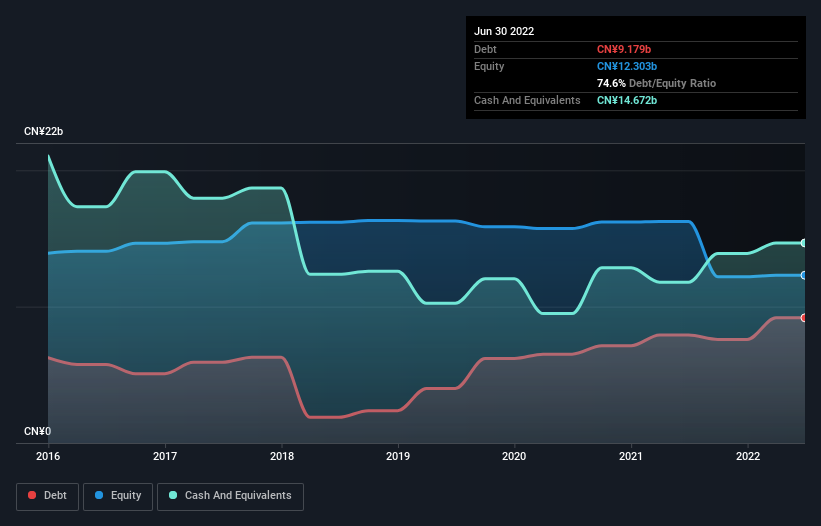
Some say volatility, rather than debt, is the best way to think about risk as an investor, but Warren Buffett famously said that 'Volatility is far from synonymous with risk.' It's only natural to consider a company's balance sheet when you examine how risky it is, since debt is often involved when a business collapses. As with many other companies Harbin Electric Company Limited (HKG:1133) makes use of debt. But should shareholders be worried about its use of debt?
When Is Debt A Problem?
Debt and other liabilities become risky for a business when it cannot easily fulfill those obligations, either with free cash flow or by raising capital at an attractive price. Ultimately, if the company can't fulfill its legal obligations to repay debt, shareholders could walk away with nothing. However, a more frequent (but still costly) occurrence is where a company must issue shares at bargain-basement prices, permanently diluting shareholders, just to shore up its balance sheet. Of course, the upside of debt is that it often represents cheap capital, especially when it replaces dilution in a company with the ability to reinvest at high rates of return. When we think about a company's use of debt, we first look at cash and debt together.
Check out the opportunities and risks within the HK Electrical industry.
How Much Debt Does Harbin Electric Carry?
You can click the graphic below for the historical numbers, but it shows that as of June 2022 Harbin Electric had CN¥9.18b of debt, an increase on CN¥7.92b, over one year. But it also has CN¥14.7b in cash to offset that, meaning it has CN¥5.49b net cash.

A Look At Harbin Electric's Liabilities
We can see from the most recent balance sheet that Harbin Electric had liabilities of CN¥45.2b falling due within a year, and liabilities of CN¥4.71b due beyond that. Offsetting this, it had CN¥14.7b in cash and CN¥22.2b in receivables that were due within 12 months. So its liabilities total CN¥13.0b more than the combination of its cash and short-term receivables.
The deficiency here weighs heavily on the CN¥3.96b company itself, as if a child were struggling under the weight of an enormous back-pack full of books, his sports gear, and a trumpet. So we definitely think shareholders need to watch this one closely. After all, Harbin Electric would likely require a major re-capitalisation if it had to pay its creditors today. Harbin Electric boasts net cash, so it's fair to say it does not have a heavy debt load, even if it does have very significant liabilities, in total. When analysing debt levels, the balance sheet is the obvious place to start. But ultimately the future profitability of the business will decide if Harbin Electric can strengthen its balance sheet over time. So if you're focused on the future you can check out this free report showing analyst profit forecasts.
Over 12 months, Harbin Electric made a loss at the EBIT level, and saw its revenue drop to CN¥21b, which is a fall of 18%. We would much prefer see growth.
So How Risky Is Harbin Electric?
Although Harbin Electric had an earnings before interest and tax (EBIT) loss over the last twelve months, it generated positive free cash flow of CN¥2.7b. So taking that on face value, and considering the net cash situation, we don't think that the stock is too risky in the near term. We're not impressed by its revenue growth, so until we see some positive sustainable EBIT, we consider the stock to be high risk. For riskier companies like Harbin Electric I always like to keep an eye on the long term profit and revenue trends. Fortunately, you can click to see our interactive graph of its profit, revenue, and operating cashflow.
At the end of the day, it's often better to focus on companies that are free from net debt. You can access our special list of such companies (all with a track record of profit growth). It's free.
Valuation is complex, but we're here to simplify it.
Discover if Harbin Electric might be undervalued or overvalued with our detailed analysis, featuring fair value estimates, potential risks, dividends, insider trades, and its financial condition.
Access Free AnalysisHave feedback on this article? Concerned about the content? Get in touch with us directly. Alternatively, email editorial-team (at) simplywallst.com.
This article by Simply Wall St is general in nature. We provide commentary based on historical data and analyst forecasts only using an unbiased methodology and our articles are not intended to be financial advice. It does not constitute a recommendation to buy or sell any stock, and does not take account of your objectives, or your financial situation. We aim to bring you long-term focused analysis driven by fundamental data. Note that our analysis may not factor in the latest price-sensitive company announcements or qualitative material. Simply Wall St has no position in any stocks mentioned.
About SEHK:1133
Harbin Electric
Manufactures and sells power plant equipment in the People’s Republic of China, the rest of Asia, Africa, Europe, and the United States.
Proven track record with adequate balance sheet.
Similar Companies
Market Insights
Community Narratives




